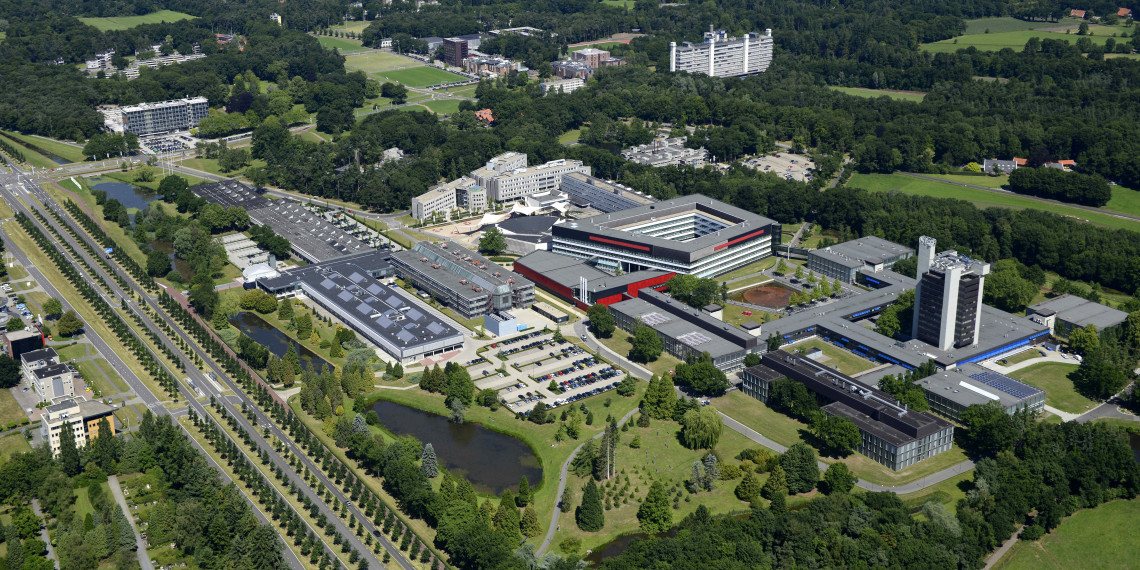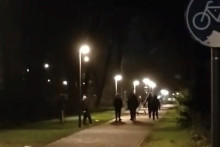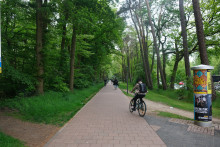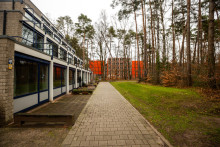Peter Timmerman, head of Studium Generale and a walking encyclopedia of UT campus history, has a clear vision on a ‘real’ campus. ‘Look at the map of the Amsterdam Science Park,’ he says, showing us a print from the website of the University of Amsterdam. ‘They present a nice green map with an open parklike environment. But…’ He reveals a new print from Google Maps. ‘But actually it looks like this: a concrete jungle. It’s a sort of greenwashing for PR purposes. Nowadays everyone seems to claim they have a campus, but the UT is the only real campus university in the Netherlands.’
Opinions on this topic differ, though. According to Alexandra den Heijer, a professor of Public Real Estate at Delft University of Technology, the definition has become much broader among universities. As the lead scientist at the Campus Research Team, she characterizes a campus as all buildings and land with a university-related function. ‘That can be lecture halls, offices and labs, but also housing, cafés and spaces for startups. This definition is therefore not just about the property of the university, but also about management and usage of required facilities, such as student housing, which is not in the hands of the university, but is used by its students. In this definition, a campus can also be located throughout a city; it is not necessarily a closed entity like in Twente.’

(Illustration: campus of the University of Virginia)
Green and isolated
‘A city campus is a contradiction in itself,’ disagrees Timmerman. ‘Campus is the Latin word for field, which you won’t find in the middle of a city.’ In his mind, the essence of a campus is being green and isolated. ‘One of the first campuses ever was founded by Thomas Jefferson: the University of Virginia in the US. It was built outside the city to keep the academic community isolated from the influences of the outside world. I think this is the reason why the nametag campus is so popular nowadays. It is associated with the utopian and idealistic idea at the first campuses in the US, which aimed to educate the best and the brightest in the country, to create a community of future leaders.’
‘A city campus is a contradiction in itself’
Historically, the first universities were in Europe and they were connected to the Church. Their origins go back to monasteries and cloisters – which were also isolated from the world. This model was copied by Jefferson and his model was used for the University of Twente, just in a more modern form. ‘It’s like a modern cloister but without the religion,’ says Timmerman. ‘Just like Jefferson’s campus, the UT has three separate areas: for education and research, for relaxation and for housing. A real campus has staff and students living on the premises and it has a green field. Jefferson’s campus also had the lawn for festivities, we have that here as well. We have a unique space for festivals, such as the Kick-In or Green Vibrations.’
UT campus architecture
Initially, the task of designing the UT campus was given to two renowned architects Wim van Tijen and Samuel van Embden. The general layout of the estate was based on American campus universities and followed principles of ‘Functionalism’. These two original architects are responsible for the large buildings, such as Spiegel, Hogekamp and Langezijds.
Perhaps to make the campus less ‘monotonous’, Van Tijen and Van Embden decided to hire a new generation of architects: so called ‘angry young men’. While the older guard focused on functional, straightforward and efficient design, the angry young men had a completely different approach. They wanted to create buildings that would facilitate social contact, that would bring people together. Hence, you can now find yourself searching for others in buildings such as Cubicus, Bastille or Vrijhof. Having these two groups of architects led to a big clash of generations and styles, but resulted in the UT campus as we know it today.
Two models
Den Heijer would define this type university as a ‘campus as a city’. ‘In this model, everything is centralized in one place. Students and staff don’t need to leave the campus. The big advantage of a campus as a city is the community feeling. In addition, you hardly lose any time by moving from building to building. This also makes multidisciplinary research easier; it is clearer where everything is located. Moreover, a foreign student will probably feel more at home in this model. The student is temporarily admitted to the community and can immerse him- or herself in the campus family. This prevents the sense of loneliness that always lurks in a large city. The campus as a city can therefore profile itself as "temporary home" for foreign students. That is a big advantage for Twente.’
‘Silence is the new scarcity in our society’
On the other end of the spectrum lies the ‘city as a campus’ model, where living, studying and relaxing are separated and spread around the city. This, Den Heijer stresses, is also referred to as a real campus with Europe’s oldest universities like Bologna, Cambridge, Oxford and Uppsala as vivid examples. ‘The advantage of the city as a campus is that the university does not have to organize all facilities itself. You can use the capacities of the city, such as the cultural facilities or the restaurants and bars. The university is less of a bubble when it is located in the city, it is less of an ivory tower. And that is exactly what universities are often blamed for nowadays: the lack of social engagement. A city as a campus is much more visible for the rest of our society. On the other hand, universities are growing and that puts a lot of pressure on a city. If universities are too big, they become almost a parasite of the city. They can take the life out of its host.’

Community feeling
Timmerman agrees that there advantages and disadvantages to both models, but he believes that it is the sense of community that truly makes a campus – and something that you can only get at the campus as a city form. ‘The campus’s isolation could be seen as elitist, but it works. Because of the campus formula, everyone is close together. You meet so many people just on your way from a meeting to a meeting. I often feel like a fly in a vanilla pie. When I walk outside, I always meet people, stop and discuss things with them. It gives you a community feeling. In earlier days I studied at what is nowadays called the Roeterseiland-campus of the UvA, but I always felt lost in space over there. At the UT campus you have a good overview of the whole university. It makes you feel connected to the people and the institute.’
Silence, please!
There are pros and cons to both variations of a campus, but why do we even need a physical space in an age where all information can be passed digitally? Wouldn’t we prefer to work or study from our own bed? Apparently not, says Alexandra den Heijer. ‘In a recent study of fourteen Dutch campuses, we discovered a remarkable trend. The former hypothesis was that contemporary technology allows students to work anywhere, resulting in lower activity in university buildings. But that hypothesis turns out to be incorrect. Nowadays, students and employees visit the campus even more. They lock themselves up to fully concentrate on a project. There is less distraction on campus.’
‘Because of the campus formula, everyone is close together’
Every future-proof campus will therefore need one crucial feature: silence. ‘Silence is the new scarcity in our society,’ states Den Heijer. ‘It is very difficult to find a place where you are not distracted. People need to find a place to be alone and focus. Silent study places are much in demand at universities right now. On the other hand, the campus is still a place for community, for being together. So, we need what we call “bipolar” facilities: silent library-like spaces where there is buzz right outside the door.’
The green Twente campus is certainly unique in this regard, acknowledges the professor. ‘It is a place with an enormous amount of space and that is what the UT community must cherish. Perhaps the campus is the new monastery. People go to the campus for a retreat, a ‘’retraite’’. In that respect, Twente certainly has good cards for the future.’
A brief history of the UT
On January 25, 1961, the municipality of Enschede offers the Drienerloo estate, of more than 96 hectares, to the national government. With this gift Twente hopes to bring the third Polytechnic University of the Netherlands to the East. And not without success: Enschede surpasses the other three candidates Arnhem, Zwolle and Deventer. The large Drienerloo estate offers more than enough space for a new type of university: the campus model, where living, studying, working and partying come together. A unique experiment in the Netherlands, at that time - and perhaps it still is unique in its kind. In 1964 Queen Juliana officially opens the UT, then called the THT (only in the summer of 1986 does the THT get its current name: University of Twente). The first group consists of two hundred students, four of whom are women. From then to now, the campus went through an enormous growth. These days, the UT hosts more than 11,000 students and more than 3,100 employees from more than eighty countries worldwide. Even after almost sixty years, one thing remains binding at the UT: the campus on the Drienerloo estate.








